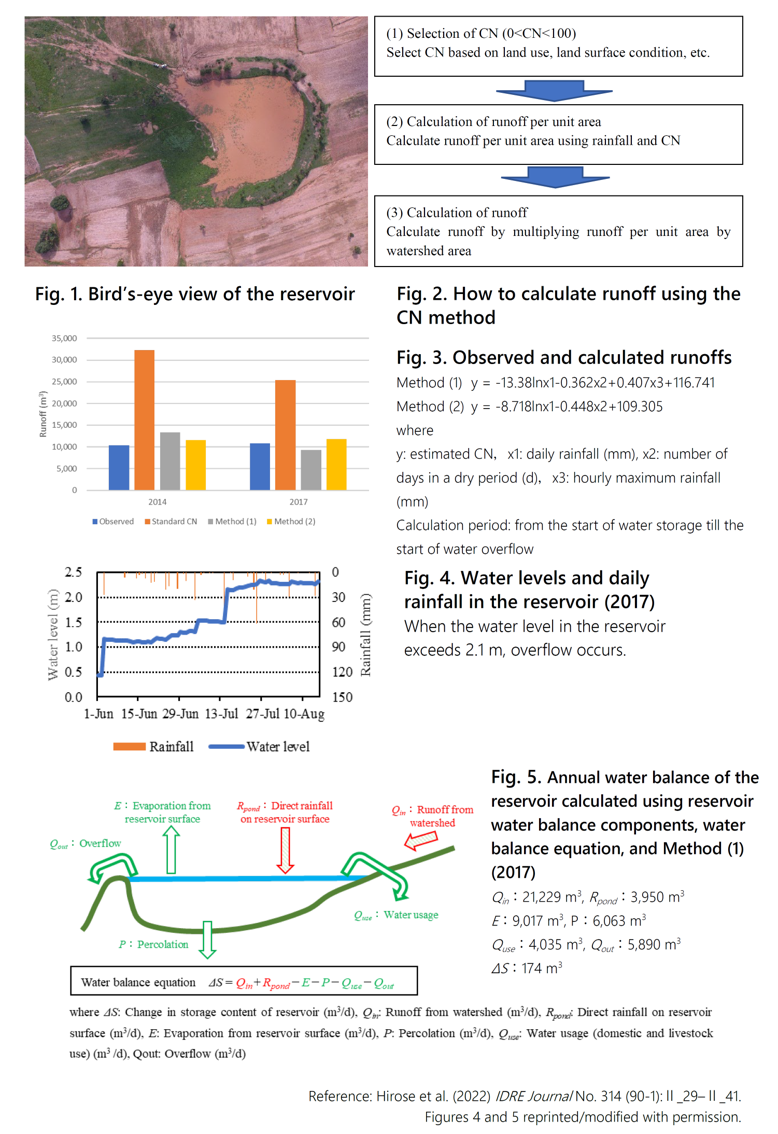A curve number estimation model to accurately calculate reservoir inflow
Description
There are many reservoirs in Northern Region, Ghana (Fig. 1). The reservoirs overflow during the rainy season, and the overflowing water flows into rivers without being used downstream. If the overflowing water can be used for irrigation, agricultural productivity is expected to increase. To utilize overflow water for irrigation, it is necessary to estimate the volume of water that flows out of the watershed when rain falls (runoff). The curve number method calculates the volume of runoff from the watershed using the curve number (CN), rainfall, and watershed area (Fig. 2). Using standard CN (Fig. 3, Standard CN), observed runoff per rainfall could not be presented (NSE=–4.46), and the difference with the observed runoff was large during the whole period (Fig. 3). This study proposes a CN estimation model to calculate runoff with accuracy and practicality.
To approximate the observed runoff, a model was devised to estimate CN by multiple regression analysis, using CN calculated backwards from the observed runoff for each rainfall as the objective variable; and daily rainfall, dry period, and hourly maximum rainfall as explanatory variables. Of the devised models, the method of estimating CN using daily rainfall (log-transformed), number of days in a dry period, and hourly maximum rainfall (Method (1)) had the best reproducibility with an average NSE of 0.74. In districts where hourly rainfall data are difficult to obtain, Method (2), which estimates CN using only daily rainfall (log-transformed) and the number of days in a dry period (NSE=0.51), is recommended. Also, methods (1) and (2) show a small difference between the observed and the calculated runoffs for the whole period (Fig. 3). Using CN estimated by these methods, runoff per rainfall can be calculated, and from the calculated runoff and the water balance equation, the volume of water that overflows (Fig. 4), i.e., when the water level in the reservoir exceeds 2.1 m, can be calculated. Applying Method (1) to 2017, it can be calculated that 5,890 m³ of overflow water was generated from the reservoir (Fig. 5). The CN estimation model devised in this study can estimate runoff using only rainfall and can be used in developing regions with data scarcity.
The “Supplementary Irrigation Manual for Rice Production Using Small Reservoirs,” which describes a method of using overflow water for irrigation in rice farming, is available on the JIRCAS website. The results of this study are based on model calculations for one of the many reservoirs in Northern Region, Ghana, hence the regression coefficients will need to be recalculated for application to other reservoirs.
Figure, table
- Research project
- Program name
- Term of research
-
FY2015–2022
- Responsible researcher
-
Hirose Chikako ( Former Rural Development Division )
MIERUKA ID: 001803Hirouchi Shinji ( Rural Development Division )
MIERUKA ID: 001783Yamada Masakazu ( Rural Development Division )
MIERUKA ID: 001786Oka Naoko ( Rural Development Division )
MIERUKA ID: 001802Furihata Hideki ( Rural Development Division )
MIERUKA ID: 001734Horino Haruhiko ( Osaka Metropolitan University )
KAKEN Researcher No.: 30212202 - ほか
- Publication, etc.
-
Hirose et al. (2022) IDRE Journal No. 314 (90-1):Ⅱ_29–Ⅱ_41. (In Japanese)https://doi.org/10.11408/jsidre.90.II_29「小規模ため池を利用した補給かんがい稲作マニュアル」 (2017)
https://www.jircas.go.jp/ja/publication/manual_guideline/irrigation_man… - Japanese PDF
-
2022_B12_ja.pdf835.07 KB
- English PDF
-
2022_B12_en.pdf602.75 KB
* Affiliation at the time of implementation of the study.

